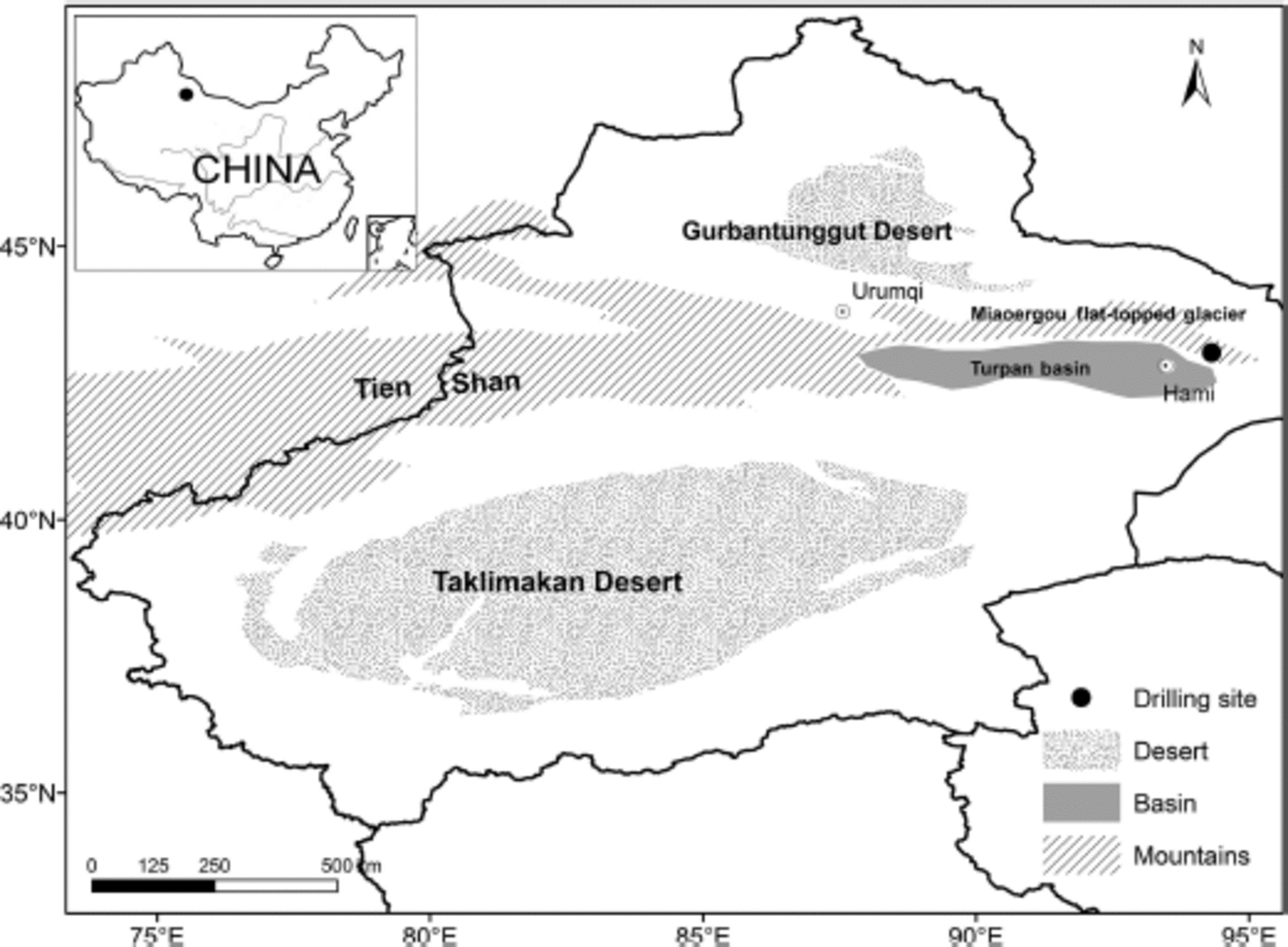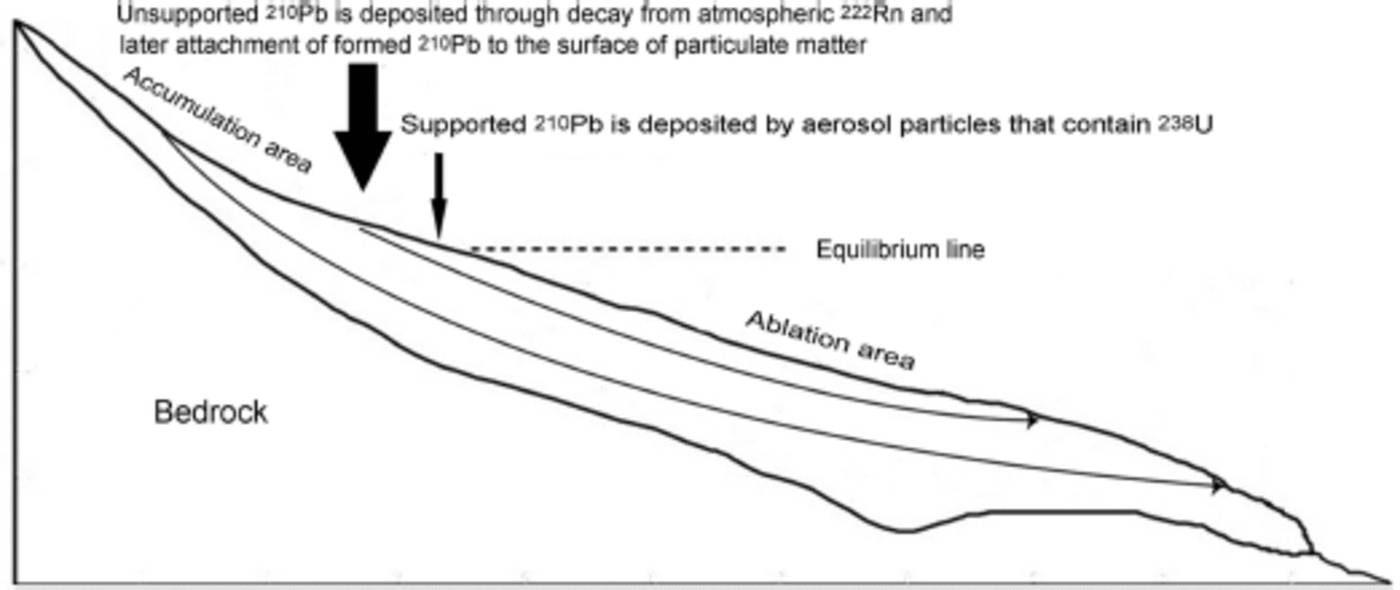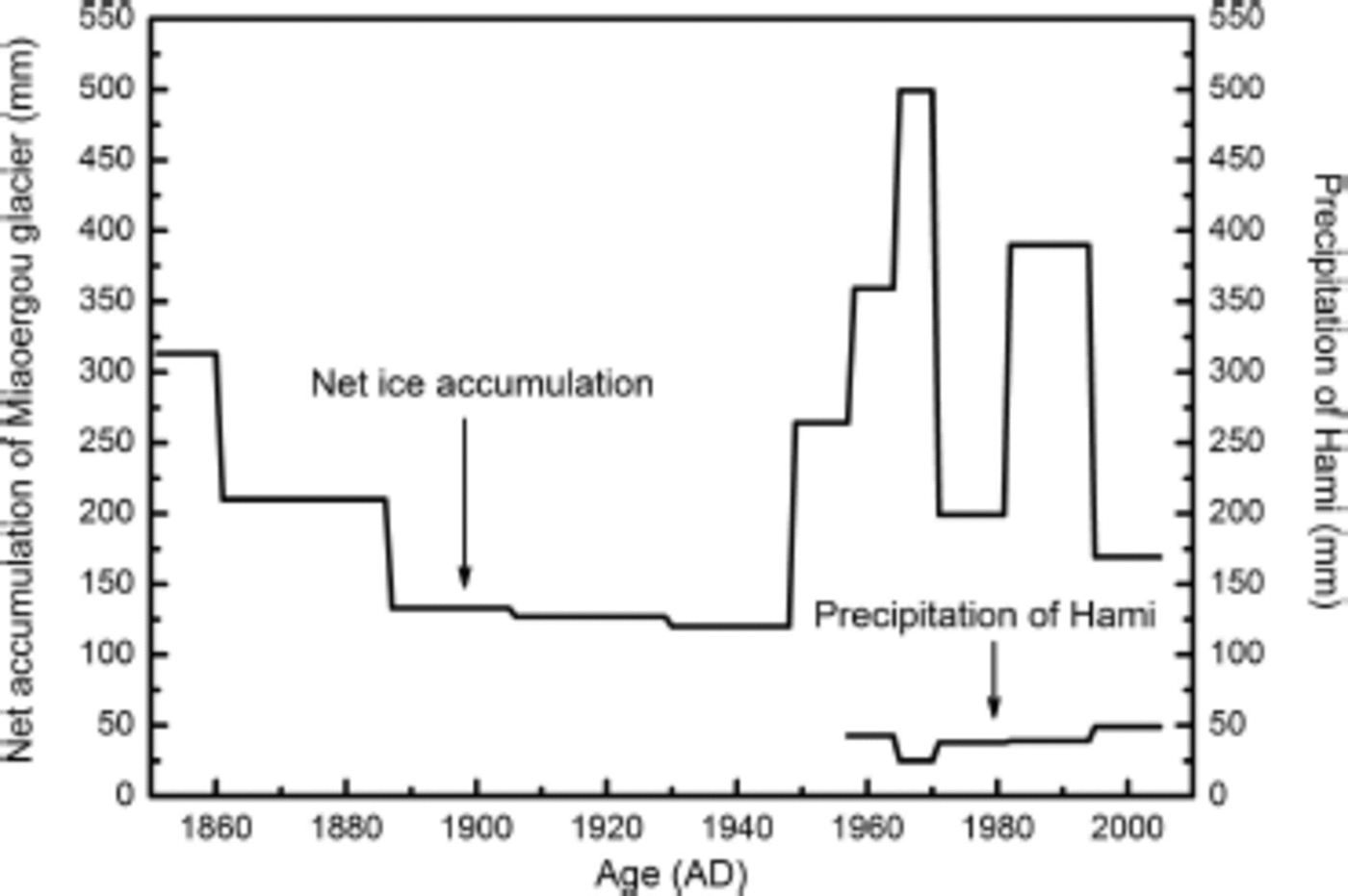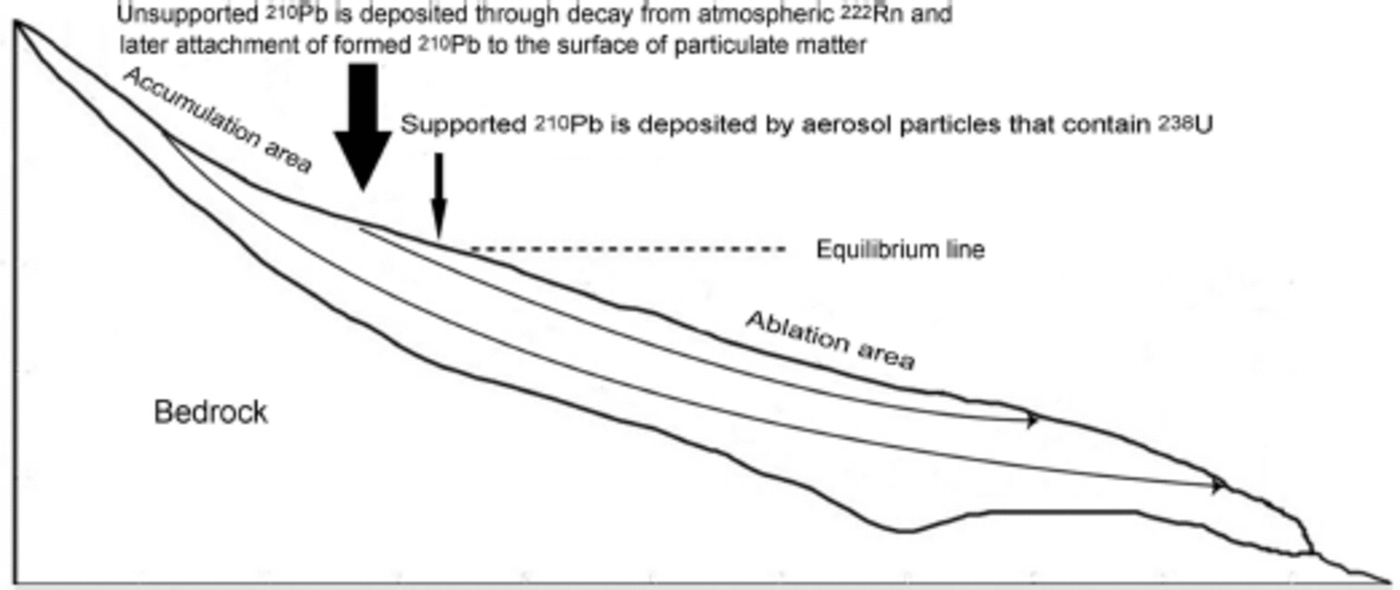Introduction
Mid- or low-latitude glaciers represent a natural archive, well suited for studying past environmental and climatic conditions (Reference Hou, Qin, Zhang, Kang, Mayewski and WakeHou and others, 2003; Reference Kang, Mayewski, Yan and QinKang and others, 2003; Reference BarbanteBarbante and others, 2004; Reference Yang and Yao Tand WangYang and others, 2006; Reference Wang, Gong, Zhang and YaoWang and others, 2010; Reference XuXu and others, 2010; Reference ShenShen and others, 2012; Reference WuWu and others, 2013). Accurate dating is an essential prerequisite for the correct interpretation of paleoclimatic information from ice-core records. For the time period covered by ice cores, ranging from decades to thousands of years, many different ice-core dating methods have been used, including profile characteristics (e.g. seasonal variation of particles; conductivity characteristics; stable isotopes and major ions contained in the core) (Reference Oeschger and LangwayOeschger and Langway, 1989; Reference AlleyAlley and others, 1997; Reference PetitPetit and others, 1999; EPICA Community Members, 2004; NorthGRIP Members, 2004; Reference SvenssonSvensson and others, 2005). The assignment of reference layers to known sources (β-activity peak from nuclear bomb debris, volcanic ash horizons, etc.) (Reference Legrand and DelmasLegrand and Delmas, 1987; Reference Cole-Dai, Mosley-Thompson, Wight and ThompsonCole-Dai and others, 2000), as well as radioisotope dating and glacier flow models, have also been used (Reference Johnsen, Dansgaard, Clausen and LangwayJohnsen and others, 1972; Reference Raisbeck and YiouRaisbeck and Yiou, 1985; Reference Raisbeck, Yiou, Bourles, Lorius, Jouzel and BarkovRaisbeck and others, 1987; Reference Ciais, Jouzel, Petit, Lipenkov and WhiteCiais and others, 1994). More than 20 dating indicators have been applied to the Greenland ice sheet GISP2 and GRIP ice cores (Reference DansgaardDansgaard and others, 1993; Reference MeeseMeese and others, 1997). The choice of the most appropriate dating method depends on the timescale and accuracy requirements. Multi-proxy annual-layer counting is the most accurate dating method (Reference AlleyAlley and others, 1997). Reference horizons are usually used to verify and cross-check the annual-layer counting dating (Reference Pourchet, Pinglot and LoriusPourchet and others, 1983; Reference EichlerEichler and others, 2000; Reference Liu, Hou, Hong, Soon, Lee and WangLiu and others, 2011).
The time range accessible using radioactive isotope 210Pb dating is ~150 years and is determined by the 22.3 year half-life of 210Pb, a product of the natural 238U decay series (Reference Gäggeler, Von Gunten, Rössler, Oeschger and SchottererGäggeler and others, 1983; Knusel and others 2003; Reference OlivierOlivier and others, 2003). 238U is the most abundant isotope of uranium, a primordial radioactive element in nature. 238U is ubiquitous in nature at an average level of ~5 ppm in soil. The half-life of 238U is 4.6 x 109 years. 238U decays after several intermediate nuclides into 222Rn which has a half-life of 3.8 days. As a noble gas, radon emanates from the Earth’s surface into the atmosphere where it decays via the very short-lived intermediate nuclides 218Po, 214Pb, 214Bi and 214Po (all having half-lives shorter than 30min) into 210Pb. 210Pb has a half-life of 22.3 years and decays into its daughter 210Bi with a half-life of 5 days, which itself decays into a ‘granddaughter’ 210Po with a half-life of 138.4 days. This means that after several half-lives of 210Po, i.e. ~1 year, the activity concentrations of all three nuclides, i.e. of 210Pb, 210Bi and 210Po, are equal (secular equilibrium). With the emission of an alpha particle, 210Po finally decays into the stable 206Pb, the end product of the 238U decay series (Reference Benoit and HemondBenoit and Hemond, 1987). Hence, the activity concentration of 210Pb can be measured by analyzing either 210Pb itself or 210Bi or 210Po after several half-lives of these progenies. Since detection of a-particles from the decay of 210Po is very sensitive and nuclide-specific, in contrast to β-particles emitted by 210Pb or 210Bi, it is advisable to determine the activity concentration of 210Pb in ice cores by analyzing the 210Po activity.
The first attempts to date ice layers using the 210Pb method were made by Reference GoldbergGoldberg (1963). Later, Reference Krishnaswamy and LalKrishnaswamy and Lal (1971) and Reference Koide, Soutar and GoldbergKoide and others (1972) made an exploratory study of 210Pb dating on lake waves and the gulf sediments. Gaggeler and others (1983) proved for the first time that the 210Pb dating method was a useful tool for dating cold high-altitude alpine glaciers. This approach has since been used to date a number of ice cores (e.g. from Illimani, Bolivia (Reference KnüselKnüsel and others, 2003); Cerro Tapado (Reference Ginot, Kull, Schotterer, Schwikowski and GäggelerGinot and others, 2006) and Monte San Valentin, Chile (Reference VimeuxVimeux and others, 2008)). However, until now there has been no reported 210Pb dating of ice cores from the Tibetan Plateau and surrounding regions. In this study, we used 210Pb to date the Miaoergou ice core drilled from the eastern Tien Shan, China.
β-activity measurements and annual-layer counting are two of the main approaches used in mountain ice-core dating. β-activity dating is based on the identification of late 1950s and early 1960s radioactive debris from nuclear weapons testing around the world, with a peak activity in the Northern Hemisphere around AD 1962-63. Annual-layer counting can be used to determine ice-core age by studying physical and chemical indicators of species that exhibit seasonal changes in the ice-core record. Examples are δ18O or chemical species that exhibit seasonal variability (e.g. ammonia from agricultural activity). As ice cores are subjected to annual-layer thinning with increasing depth, the method can only determine the age of the upper part of the ice core, i.e. is limited to a relatively short period. The 210Pb dating method yields a continuous age-depth relationship for up to two centuries and has been widely used in recent years (Knusel and others, 2003; Reference Cecil, Green and ThompsonCecil and others, 2004; Reference Ginot, Kull, Schotterer, Schwikowski and GäggelerGinot and others, 2006; Reference VimeuxVimeux and others, 2008).
Some assumptions have to be made for successful application of the 210Pb dating method. The amount of supported 210Pb coming from the 238U content in mineral dust contained in the ice should be constant and the mean 210Pb activity in precipitation should have remained constant during the dating period (CF:CS model assumption, where CF stands for constant rate of supply and CS for constant activity concentration in precipitation (Reference ApplebyAppleby, 2001). Moreover, there should be no significant transport of 210Pb by percolating meltwater. During the warm season, in daytime the air temperature may rise above 0°C. However, the formed meltwater will refreeze during the night (Reference ShumskiyShumskiy, 1964) or due to the negative temperatures inside the ice (Reference Liu, Hou, Ren and Wang Yand GenLiu and others, 2006). The night temperature decreased from –2.92°C at 1m to –7.62°C at 8m depth and gradually increased to –6.25°C from 8 to 20 m depth (Reference Song, Hou and LiuSong and others, 2011). We therefore conclude that the melting process has little impact on the 210Pb dating.
Materials and Methods
Ice-core sampling
The Miaoergou flat-topped glacier covers an area of -3.45 km2. Its altitude from the summit to the ice tongue ranges from 4512 to 3840 m, and the equilibrium-line altitude is ~4100ma.s.l. (LIGG, 1986). In 2005, two ice cores to bedrock (58.7 and 57.6 m length for cores 1 and 2, respectively) were recovered from a dome on Miaoergou glacier (43° 03 ʹ19ʺN, 94°19ʹ21ʺE; 4512ma.s.l.) (Reference Liu, Hou, Hong, Soon, Lee and WangLiu and others, 2011; Fig. 1). The low borehole temperature at the drilling site (-7.2°C at 10 m depth and -8.2°C at the bottom) is beneficial for the preservation of ice-core records (Reference Liu, Hou, Wang and SongLiu and others, 2009). The ice cores were transported frozen to the State Key Laboratory of Cryospheric Sciences, Lanzhou, China, for processing. A first study of trace elements contained in core 2 was performed down to 17 m (14 m w.e.) (Reference Liu, Hou, Hong, Soon, Lee and WangLiu and others, 2011). Besides some heavy metals, the bomb peak assigned to the period AD 1962-63 was also found at ~12.5 m depth (11 m w.e.) by total β-counting of 90Sr and 90Y in the ice samples (Reference Liu, Hou, Hong, Soon, Lee and WangLiu and others, 2011). This yielded an average net annual accumulation rate of 259 mm w.e. a-1. From annual-layer counting based on heavy-metal concentrations, an age of AD 1953 was deduced at 17m depth (14 m w.e.), resulting in an average net accumulation rate of 269 mm w.e. a–1. The analysis was stopped at 17m depth (assigned to AD 1953) due to lack of dating of the deeper part of the core. In this paper, we present a further dating of core 2 using the 210Pb dating method.

Fig. 1. Location of the Miaoergou flat-topped glacier in the eastern Tien Shan, China. The black dot shows the position of the drilling site (4380301900 N, 9481902100 E; 4512ma.s.l.).
Experiment
The ice samples are processed according to the standard method established by Gaggeler and others (2011). Each of the ice samples was cut parallel to the drilling axis in a -18°C cold room at the State Key Laboratory of Cryospheric Sciences. The weight of each sample was -300 g. Each sample was melted after adding 10mL conc. HCl, 1g NH4OH-HCl per 100g ice. NH4OH-HCl served as a reducing agent to ensure polonium stays in an elemental state in the acidified solution. Then 100 mL 209Po tracer was added to the solution to determine the yield of the separation. Spontaneous deposition of Po on an Ag disk (15 mm diameter), which was fixed on a wire and immersed in the liquid, was achieved during - 8 hours at 95°C in 500 mL Erlenmeyer flasks using a magnetic stirrer. Typical chemical and counting yields were -80%. After drying, the disks were transferred to the University of Bern for accounting. The samples were positioned in vacuum chambers at a distance of 1 mm from silicon surface barrier detectors (ORTEC, ruggedized, 300 and 450 mm2) having an a-energy resolution of - 2 3 keV full width at half-maximum (FWHM) at 5.3 MeV. The yield of 209Po tracer was measured via its 4.9 MeV a-line. Typical counting yields were -45%.
Age calculation method
The 210Pb activity concentration of glacier ice has two components: a supported component derived from the 238U (equal to the 226Ra) decay rate, and an unsupported (or excess) component derived from the atmospheric fallout of 210Pb (marked as 210Pbex). Supported 210Pb is deposited by aerosol particles that contain 238U, while excess 210Pb is deposited through decay from atmospheric 222Rn and later attachment of formed 210Pb to the surface of particulate matter (Fig. 2). The supported 210Pb activity can be determined by measuring the value of the experimental background at ages not accessible by the 210Pb method (Reference WanWan, 1997), and the excess 210Pb activity can be determined by subtracting the supported 210Pb activity from the total 210Pb activity concentration (marked as 210Pbtot) (Reference Appleby and OldfieldAppleby and Oldfield, 1983). The age of an ice core can then be calculated applying the decay law to the measured 210Pbex activities along the ice core. As the supported 210Pb values are assumed to be constant along the ice core, the age was calculated using the 210Pbex values applying the CF:CS model. This model assumes a constant rate of deposition, i.e. of annual precipitation rates, and that the activity concentration of 210Pb in precipitation remained constant over time, independent of the amount of precipitation during a given snowfall (Reference WanWan, 1997; Xia and Xue, 2004; Reference Zhang and LiuZhang and others, 2008, 2012).

Fig. 2. Sketch of a glacier profile showing the main sources of 210Pb. The 210Pb activity of glacier sediments has two components: a supported component deriving from the 2 3 8U (equal to the 226Ra) decay, and an unsupported (or excess) component deriving from the atmospheric fallout of 210Pb (marked as 210Pbex).
Results and Discussion
The 210Pb activity profile
The record of the 210Pbtot activity concentrations measured along the ice core is depicted in Figure 3, which shows an exponential decrease as a function of depth in line with the radioactive decay law. The 210Pbtot activity concentrations below 35.2 mw.e. down to bedrock were constant, with a value of 5.48±0.16 mBq kg–1. This value was taken as supported 210Pb from the mineral dust contained in the ice core and was therefore subtracted from all total 210Pb activity concentration above 35.2 mw.e. to obtain the 210Pbex values.

Fig. 3. Correlation between 210Pbt o t activity concentrations and depth of ice core from Miaoergou flat-topped glacier. An exponential fit function was applied to the scatter plots, and the coefficient of determination (r 2) was 0.987. The 210Pbto t activity concentrations show a negative exponential decrease as function of depth in line with radioactive decay law.
The data depicted in Figure 4 represent the resulting 210Pbex activity concentrations as a function of depth. We observed some fluctuations in the exponential decrease of the 210Pbex activity concentrations, which we ascribe to variations in precipitation rates (see below). This indicates that the input of 210Pb at this drilling site was on average constant during the dating period, in accord with the assumption of the CF:CS dating model. From the linear regression of the logarithmic 210Pb activities against depth we conclude that at a depth of 35.2 mw.e. of ice core the year AD 1851 ± 6 is reached. The value of the axis intercept (~400 mBq kg–1) corresponds to the 210Pbex activity at the surface of Miaoergou glacier. From the slope of the regression line, we derive a mean annual net accumulation rate of 229±7mmw.e.a-1. The estimated age-depth relation has an uncertainty of ±6 years.

Fig. 4. 210Pbex activity concentrations (scatter plots, left-hand logarithmic scale), annual-layer counting (solid line) and β-counting (bars) of ice core from Miaoergou flat-topped glacier. The rightmost axis depicts the age deduced from the 210Pbex measurement. The estimated age-depth relation has uncertainties of ±6 years. The dot-dashed line indicates the average 210Pb decrease. The dashed line indicates the bomb horizon deduced from β-counting assigned to the period AD 1962-63, which agrees well with the results of annual-layer counting and the 210Pb dating method.
Figure 4 compares the 210Pb dating results with the chronological sequence obtained from annual-layer counting results (until 1953) and the β-counting method which assays the β-activity peak of 90Sr and 90Y from the atmospheric nuclear testing period AD 1962-63. The 210Pb dating agrees within error well with the bomb horizon during AD 1962-63 at 11 mw.e. but also with the annual counting result of AD 1953 at 14mw.e. The results of different dating methods are therefore highly consistent, indicating that the result of the 210Pb dating method applied to the Miaoergou ice core is reliable. The linear decay of the depicted 210Pbex activity concentrations with depth also corroborates the assumption that no significant thinning of the ice core can be observed down to 35.2 mw.e.
210Pbex activity at the surface
The surface activity concentration of ~400 mBq kg–1 is remarkably high, even higher than observed at other continental sites such as at Belukha, Russia (280 mBq kg–1; Reference OlivierOlivier and others, 2006), or nearby Tsambagarav, Mongolia (Reference Herren, Türler, Schwikowski and BlattmannHerren and others, 2011), with the same surface activity concentration. This means that the 222Rn concentration in air in the eastern Tien Shan must be very high and the 238U concentration in soil of the regional environment must also be high. In addition, emanation of 222Rn is closely related to the geographical and climatic conditions of the study area. Any changes in atmospheric pressure, temperature, weather conditions, soil moisture, vegetation coverage, etc., will affect the release of 222Rn from the Earth’s surface, and thus affect the 210Pb concentration in the atmosphere. It might therefore be desirable to measure 222Rn activity concentrations in the study area as well as 238U concentration values in soil.
Mean net accumulation rates
Glaciers in this area near the Gobi Desert are the major water supply for the extremely arid land of Hami, an oasis city close to the Miaoergou flat-topped glacier. Reference Luo, Qi, Xu and LiLuo and others (2002) and Reference Zhang and LiuZhang and Liu (2011) pointed out that, based on field studies, precipitation rates in the area above 4000 ma.s.l. in the Yushugou basin (438020-438110 N, 938570-948190E) are up to 400-500 mm a–1. This value is in reasonably good agreeement with our value of 229±7 mmw.e.a-1. From the 1957-2005 precipitation data at Hami weather station we obtain an average annual precipitation rate of 38 mm a–1 (Fig 5). The precipitation rates at Hami show a weak trend towards increasing values, in accordance with the trend of warmer and wetter climate in northwest China (Reference ShiShi and others, 2003).

Fig. 5. Changes in net accumulations of Miaoergou flat-topped glacier from AD 1851 to 2005 deduced from the 2 1 0Pbe x values and the precipitations of Hami from AD 1957 to 2005. For the period 1851–2005, we calculated the net accumulations at different time intervals according to the results of the 2 1 0Pb dating method. For the period 1957–2005, we calculated the precipitations of Hami at the same time intervals as the net accumulations.
Conclusions
The 210Pb dating method has been applied to a 57.6 m ice core from Miaoergou glacier recovered at 4512ma.s.l. in 2005. The investigated samples have been worked up for 210Po which was assayed by a-spectroscopy to deduce the 210Pb activity concentration at secular equilibrium. The surface activity concentration of 210Pbex at this site is ~400 mBq kg–1 which is very high compared to other sites worldwide. Using the 210Pb CF:CS dating model, we conclude that at a depth of 35.2 mw.e. the year AD1851 ±6 is reached The resulting mean net annual accumulation rate is 229±7mmw.e.a-1. The results of the 210Pb dating method, of annual-layer counting and of β-counting are highly consistent, which indicates that the result of the 210Pb dating method applied to the Miaoergou ice core is reliable and can be used to date the ice core to ages older than 1953, the limiting age prior to this study.
This work shows for the first time that 210Pb dating is a suitable method for dating glaciers in the eastern Tien Shan. This method could also be used to date other ice cores recovered from the mountains of western China.
Acknowledgements
We greatly appreciate the efforts of all field personnel on the scientific expedition to the Miaoergou flat-topped glacier in 2005. This research was funded by the National Natural Science Foundation of China (41330526, 41171052, 41321062 and 40825017), the National Basic Research Program of China (2010CB951401), the Chinese Academy of Sciences (XDB03030101-4) and the Fundamental Research Funds for the Central Universities (1082020904, 20110091110025). H.W.G. greatly appreciates the hospitality he received during his visit to Nanjing University.









